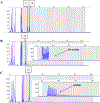Myotonic dystrophy type 1 testing, 2024 revision: A technical standard of the American College of Medical Genetics and Genomics (ACMG)
- PMID: 38836869
- PMCID: PMC11298302
- DOI: 10.1016/j.gim.2024.101145
Myotonic dystrophy type 1 testing, 2024 revision: A technical standard of the American College of Medical Genetics and Genomics (ACMG)
Abstract
Myotonic dystrophy type 1 (DM1) is a form of muscular dystrophy causing progressive muscle loss and weakness. Although clinical features can manifest at any age, it is the most common form of muscular dystrophy with onset in adulthood. DM1 is an autosomal dominant condition, resulting from an unstable CTG expansion in the 3'-untranslated region of the myotonic dystrophy protein kinase (DMPK) gene. The age of onset and the severity of the phenotype are roughly correlated with the size of the CTG expansion. Multiple methodologies can be used to diagnose affected individuals with DM1, including polymerase chain reaction, Southern blot, and triplet repeat-primed polymerase chain reaction. Recently, triplet repeat interruptions have been described, which may affect clinical outcomes of a fully-variable allele in DMPK. This document supersedes the Technical Standards and Guidelines for Myotonic Dystrophy originally published in 2009 and reaffirmed in 2015. It is designed for genetic testing professionals who are already familiar with the disease and the methods of analysis.
Keywords: Myotonic dystrophy; Technical standard; Testing methodologies; Trinucleotide repeats.
Copyright © 2024 American College of Medical Genetics and Genomics. Published by Elsevier Inc. All rights reserved.
Conflict of interest statement
Conflict of Interest Honey V. Reddi, Benjamin E. Kang, and Lora J.H. Bean all serve as directors in clinical laboratories that perform a breadth of genetic and genomic analyses on a fee-for-service basis. Honey V. Reddi is a Consultant Director for Biofidelity Inc. Bryce A. Seifert is a salaried employee of Guidehouse, LLP. All other authors declare no conflicts of interest.
Figures



References
-
- Bird TD. Myotonic dystrophy type 1. In: Adam MP, Mirzaa GM, Pagon RA, et al. , eds. GeneReviews. September 17, 1999. Last update: March 25, 2021. University of Washington; 1993.
-
- Schoser B Myotonic dystrophy type 2. In: Adam MP, Mirzaa GM, Pagon RA, et al. , eds. GeneReviews. September 21, 2006. Last update: March 19, 2020. University of Washington; 1993.
Publication types
MeSH terms
Substances
Grants and funding
LinkOut - more resources
Full Text Sources
Medical

